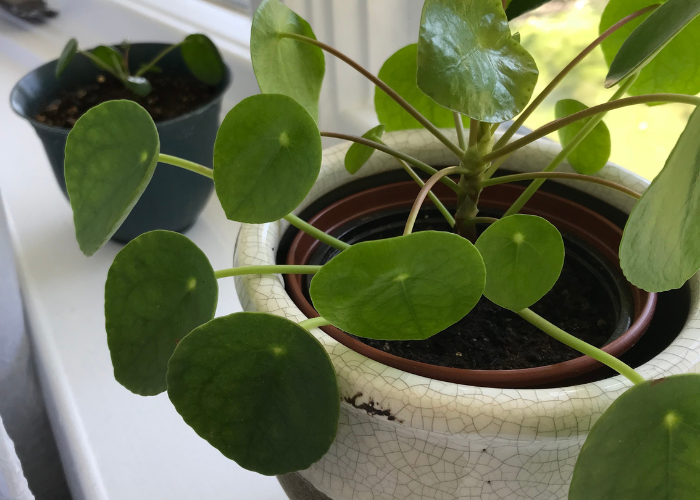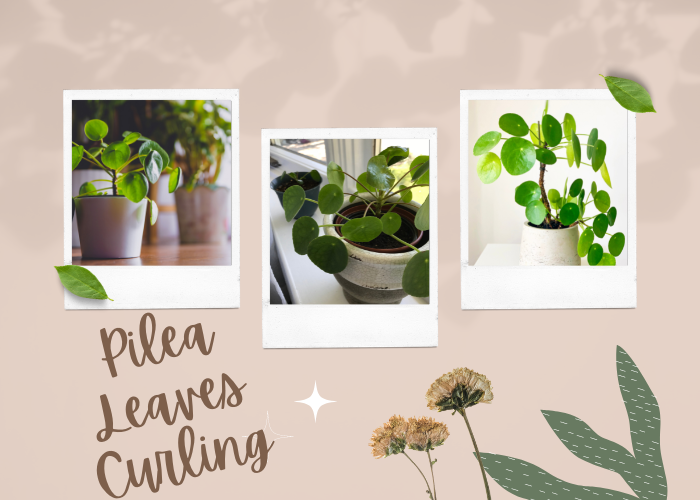Pilea plants, also known as Chinese money plants, have become popular recently for their unique appearance and easy care requirements. However, like any plant, Pilea can only experience problems if correctly cared for.
One common issue is the curling of the plant’s leaves. This article will discuss the causes of Pilea leaves curling, how to diagnose the problem and the best methods for treating and preventing it.
Types of Leaf Curling in Pilea
Pilea plants are beautiful and easy to care for, but sometimes they can develop leaf curling. Various factors, including environmental stress, pests, and diseases, can cause leaf curling. There are three types of leaf curling in Pilea plants: upward curling, inward curling and downward curling.
Upward Curling
Upward curling is when the edges of the leaves curl upwards. It is typically caused by dry air, insufficient watering, or excessive fertiliser. When the air is dry, the plant loses water through its leaves, causing them to curl upwards.
Insufficient watering can also cause upward curling, as the plant becomes dehydrated and tries to conserve water by curling its leaves. Excessive fertiliser can cause a buildup of salts in the soil, leading to upward curling.
Downward Curling
Downward curling is when the edges of the leaves curl downwards. It is typically caused by overwatering, cold temperatures, or pests. Overwatering can cause the roots to rot, leading to leaf curling.
Cold temperatures can cause the plant to go into shock and curl its leaves downwards. Pests such as spider mites and mealybugs can also cause leaf curling by sucking the sap out of the plant.
Inward Curling
Pilea plants are known for their unique and attractive foliage, but sometimes their leaves may start curling inwards, which can cause concern. Pilea leaves curling inwards is when the edges of the leaves curl towards the middle, giving the appearance of a rolled-up leaf. The most common cause of inward curling is underwatering.
Identifying the type of leaf curling is essential to determine the underlying cause and take appropriate action. For upward curling, it’s essential to increase humidity levels, water the plant properly, and avoid excessive fertilisation. For downward curling, it’s essential to ensure proper drainage, avoid overwatering, and protect the plant from cold temperatures and pests.
Causes of Pilea Leaves Curling
When you see Chinese money plant leaves curling, it can be frustrating and concerning for plant owners. However, understanding the root causes can help resolve the issue and prevent it from occurring. Let’s dive into the various reasons why Pilea leaves may curl.
Environmental Factors
Environmental factors play a substantial role in the health of Pilea plants. Temperature and humidity outside the plant’s preferred range can cause stress and pilea curling leaves. Pilea plants prefer a temperature range of 60 to 75 degrees Fahrenheit and high humidity levels of around 50 to 60%. The leaves may curl if the temperature is too high or low or if the humidity is too low.
Watering Issues
Watering issues can also cause Pilea leaves to curl. Over-watering the plant can lead to root rot, which prevents the roots from absorbing nutrients and water properly. This can cause the leaves to curl as the plant struggles to get the necessary nutrients to support healthy leaf growth. On the other hand, under-watering the plant can cause dehydration, leading to curled leaves.
Soil Problems
Soil problems are another common cause of Pilea leaves curled. Compacted soil can prevent water and air from reaching the roots, leading to stress and curled leaves. Nutrient deficiencies in the soil can also cause the plant to become unhealthy and display curled leaves.
Pest Infestations
Pest infestations, such as spider mites and mealybugs, can cause stress on the plant, leading to curled leaves. These pests can feed on the plant’s sap and cause damage to the leaves and stem. Additionally, fungal or bacterial infections can also cause leaf curling.
Did you know? Pilea plants are sometimes called “UFO plants” because of their distinctive round leaves.
Diagnosing Pilea Leaves Curling
Diagnosing the reason for Pilea leaves curling can be a challenging task for plant owners. However, a few essential steps can help determine the cause and help to find the right solution to address the issue.
Examine the Leaves
The first step is to examine the leaves of the Pilea plant. If the edges of the leaves are curling upward, it may be a sign of high humidity levels or underwatering. In contrast, if the edges curl downwards, it may indicate overwatering or soil problems. If the entire leaf is curling, it could be a sign of environmental stress, pests, or disease.
Inspect the Plant
Next, inspect the plant as a whole. Check the soil’s moisture level by sticking your finger into the soil up to your knuckle. If the soil is dry, the plant may need more water. If it’s too wet, the plant may have root rot, which can cause curled leaves. Also, check the plant’s pot to ensure proper drainage and ventilation.
Check for Pests and Diseases
Pests and diseases can also cause Pilea leaves to curl. Scrutinise the plant for signs of infestation. Spider mites and mealybugs are common pests that can cause leaf curling. Fungal or bacterial infections can also cause curled leaves. If you find any signs of pests or diseases, take immediate action to treat the plant.
Consider Environmental Factors
Lastly, consider environmental factors. Pilea plants prefer temperatures between 60 to 75 degrees Fahrenheit and high humidity levels between 50 to 60%. If the temperature is too low or high or the humidity is too low, it can cause stress to the plant and result in curled leaves. Ensure the plant is placed in the right spot with adequate lighting and protection from drafts.
Now for an interesting fact: Pilea plants are popular among plant lovers for their unique appearance and air-purifying abilities. These plants can help to remove harmful toxins from the air, making them a perfect addition to any indoor space.
Treating Pilea Leaves Curling

Treating Pilea leaves curling is essential to ensure the plant’s health and maintain its beautiful appearance. Here are some practical ways to treat curled leaves:
Adjust Watering
Overwatering or underwatering can cause Pilea leaves to curl. If the soil is too dry, water the plant thoroughly and ensure that the soil is moist but not soggy. On the other hand, if the soil is too wet, allow it to dry out before watering again.
Improve Soil Quality
Compacted soil can prevent water and air from reaching the roots, leading to curled leaves. Repotting the plant in a well-draining soil mix with adequate nutrients can help resolve the issue.
Provide Adequate Humidity
Pilea plants prefer high humidity levels. If the air is too dry, the plant can become stressed, resulting in curled leaves. Misting the plant regularly or placing a humidifier near the plant can help maintain adequate humidity levels.
Adjust Temperature
Pilea plants prefer temperatures between 60 to 75 degrees Fahrenheit. If the temperature is too low or high, it can cause stress and lead to curled leaves. Adjusting the plant’s placement in a suitable spot with proper temperature levels can help resolve the issue.
Treat Pests and Diseases
Pests and diseases can cause stress to the plant, resulting in curled leaves. Treating the plant with appropriate pesticides or fungicides can help to eliminate pests or diseases and prevent further damage to the plant.
An interesting fact: Pilea plants are known for their unique ability to propagate quickly. They produce small offsets or “pups” that can be separated from the parent plant and potted individually, growing into a new plant. This makes them an excellent choice for plant owners who want to expand their collection or share plants with friends and family.
Preventing Pilea Leaves Curling
Preventing Pilea leaves from curling is essential not only for the plant’s health but also for aesthetic reasons. A Pilea plant with curled leaves can look unhealthy and unsightly, detracting from its beauty.
- Proper watering is one of the most effective ways to prevent Pilea leaves from curling. Overwatering or underwatering can cause stress to the plant and lead to leaf curling. It’s essential to water the plant when the top inch of soil feels dry and ensure the soil has proper drainage.
- Another critical factor in preventing leaf curling is providing adequate lighting. Pilea plants require moderate to bright indirect sunlight, and insufficient light can cause stress and lead to leaf curling. Placing the plant in a spot that receives adequate natural or artificial grow lights can help prevent this issue.
- Maintaining proper humidity levels is also vital in preventing leaf curling. Pilea plants prefer high humidity levels; dry air can cause stress and lead to leaf curling. Regular misting or using a humidifier can help maintain adequate humidity levels and prevent leaf curling.
- Using an appropriate soil mix that drains well and provides adequate nutrients is another essential aspect of preventing Pilea leaves from curling. Soil-related issues such as root rot can cause stress and lead to leaf curling.
- Lastly, preventing pest and disease infestations is crucial in preventing leaf curling. Inspecting the plant regularly and promptly addressing any issues can prevent stress on the plant and keep it healthy and beautiful.
Fun fact: The Pilea plant’s popularity exploded after a Norwegian missionary discovered it growing in the mountains of China in the 1940s. He brought some plants back to Norway and shared them with friends and family, starting a continued trend.
Wrap Up!
In conclusion, Pilea leaves curling can be caused by several factors, including environmental conditions, watering issues, soil problems, and pest infestations. Diagnosing the cause of the problem is crucial to properly treating and preventing Pilea leaves from curling.
By maintaining consistent environmental conditions, regularly checking for pests and diseases, and ensuring proper watering and fertilisation, Pilea plants can thrive and display healthy, vibrant leaves.
To learn more about plant care, follow Kitchen and Gardening!
FAQs
What does an overwatered Pilea look like?
An overwatered Pilea may have yellowing leaves, wilting, and root rot.
How do you fix curling leaves?
To fix curling leaves, you should identify the cause, such as underwatering, overwatering, or pests, and adjust your care accordingly.
Why is my Chinese Money Plant leaves curling inwards?
Chinese Money Plant leaves may curl inward due to underwatering, low humidity, or pests.
Why are my Pilea leaves curling and turning yellow?
Pilea leaves may curl and turn yellow due to overwatering, root rot, or low humidity.
Can curled leaves go back to normal?
Curled leaves may not return to normal, but improving plant care can prevent further damage and encourage healthy growth.














Leave a Reply